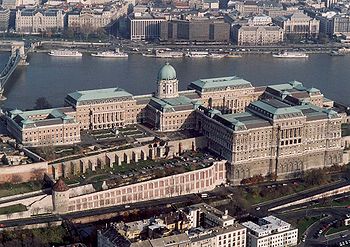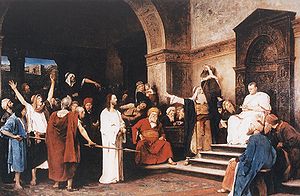
Hungarian National Gallery
Encyclopedia

Art
Art is the product or process of deliberately arranging items in a way that influences and affects one or more of the senses, emotions, and intellect....
museum
Museum
A museum is an institution that cares for a collection of artifacts and other objects of scientific, artistic, cultural, or historical importance and makes them available for public viewing through exhibits that may be permanent or temporary. Most large museums are located in major cities...
. It is located in Buda Castle
Buda Castle
Buda Castle is the historical castle and palace complex of the Hungarian kings in Budapest, first completed in 1265. In the past, it was also called Royal Palace and Royal Castle ....
in Budapest
Budapest
Budapest is the capital of Hungary. As the largest city of Hungary, it is the country's principal political, cultural, commercial, industrial, and transportation centre. In 2011, Budapest had 1,733,685 inhabitants, down from its 1989 peak of 2,113,645 due to suburbanization. The Budapest Commuter...
, Hungary
Hungary
Hungary , officially the Republic of Hungary , is a landlocked country in Central Europe. It is situated in the Carpathian Basin and is bordered by Slovakia to the north, Ukraine and Romania to the east, Serbia and Croatia to the south, Slovenia to the southwest and Austria to the west. The...
. Its collections cover Hungarian art in all genres, including the many twentieth-century Hungarian artists who worked in Paris and other locations in the West. The primary museum for international art is the Museum of Fine Arts
Museum of Fine Arts (Budapest)
The Museum of Fine Arts is a museum in Heroes' Square, Budapest, Hungary, facing the Palace of Art.It was built by the plans of Albert Schickedanz and Fülöp Herzog in an eclectic-neoclassical style, between 1900 and 1906. The museum's collection is made up of international art , including all...
.
The exhibitions of the museum are divided into the following sections:
- Medieval and renaissance stone sculptures;
- Gothic art in wood (figurines and paintings);
- Late Gothic altars;
- Renaissance and baroque arts;
- 19th and 20th-century painting, photography, sculpture, and graphic art and prints (including designs for stamps); and
- Contemporary art - displaying the art works of Mihály MunkácsyMihály MunkácsyMihály Munkácsy was a Hungarian painter, who lived in Paris and earned international reputation with his genre pictures and large scale biblical paintings.-Early Years of Munkácsy:...
and László PaálLászló PaálLászló Paál was a Hungarian Realist landscape painter. He was a pupil of Mihaly Munkacsy. His pictures are representative of lyrical realism: his oeuvre is related to the tendencies of the Barbizon School.-External links:*...
.
Medieval and renaissance stone art
The Medieval and Renaissance collection includes works in stone and marble from the 11th to the 16th century.Gothic wooden statues and paintings
The GothicGothic art
Gothic art was a Medieval art movement that developed in France out of Romanesque art in the mid-12th century, led by the concurrent development of Gothic architecture. It spread to all of Western Europe, but took over art more completely north of the Alps, never quite effacing more classical...
wood
Wood
Wood is a hard, fibrous tissue found in many trees. It has been used for hundreds of thousands of years for both fuel and as a construction material. It is an organic material, a natural composite of cellulose fibers embedded in a matrix of lignin which resists compression...
sculpture
Sculpture
Sculpture is three-dimensional artwork created by shaping or combining hard materials—typically stone such as marble—or metal, glass, or wood. Softer materials can also be used, such as clay, textiles, plastics, polymers and softer metals...
s and pictures in the gallery date from the 14th to the 15th century.
Late Gothic altars

Gothic art
Gothic art was a Medieval art movement that developed in France out of Romanesque art in the mid-12th century, led by the concurrent development of Gothic architecture. It spread to all of Western Europe, but took over art more completely north of the Alps, never quite effacing more classical...
altars date from the 15th century to the 16th century.
Renaissance and Baroque Art
The renaissanceRenaissance
The Renaissance was a cultural movement that spanned roughly the 14th to the 17th century, beginning in Italy in the Late Middle Ages and later spreading to the rest of Europe. The term is also used more loosely to refer to the historical era, but since the changes of the Renaissance were not...
and baroque
Baroque
The Baroque is a period and the style that used exaggerated motion and clear, easily interpreted detail to produce drama, tension, exuberance, and grandeur in sculpture, painting, literature, dance, and music...
Hungarian art collection dates from 1550 to 1800.
19th and 20th-century art
The museum displays a number of works from national Hungarian sculptors such as Károly AlexyKároly Alexy
Károly Alexy was a Hungarian sculptor. His sculptural style integrated elements of classicism and romanticism....
, Maurice Ascalon
Maurice Ascalon
Maurice Ascalon , a designer and sculptor, is, by some accounts, considered the father of the modern Israeli decorative arts movement.- Biography :Maurice Ascalon was born as Moshe Klein in eastern Hungary...
, Miklós Borsos
Miklós Borsos
Miklós Borsos was a Hungarian sculptor. His style integrated elements of archaic art and classicism with modern elements.Born in Nagyszeben, Transylvania , he and his family settled in Győr in 1921; Borsos and his wife lived in the same Győr house until the end of World War II.He became interested...
, Gyula Donáth
Gyula Donáth
Gyula Donáth , was a Hungarian sculptor.He was born in Pest and studied in Vienna with G. Semper. From 1880 onwards he worked in Budapest. His sculptural style integrated elements of classicism and academic as well as the Art Nouveau styles...
, János Fadrusz
János Fadrusz
János Fadrusz was a Hungarian sculptor. He was a celebrated artist of the age with many important public commission.-Early life:...
, Béni Ferenczy
Béni Ferenczy
Béni Ferenczy was a Hungarian sculptor and graphic artist.Born the son of Károly Ferenczy, he studied art in Munich and Paris where he studied with both Bourdelle and Archipenko His art became mature after he had returned from emigration in Germany and the Soviet Union.After his experiences with...
, István Ferenczy
István Ferenczy
István Ferenczy was a nineteenth century Hungarian sculptor.-Artistic education:Ferenczy was born in Rimaszombat...
and Miklós Izsó
Miklós Izsó
Miklós Izsó - May 29, 1875, Budapest) was a Hungarian sculptor. His sculptural style integrated elements of classicism and academic style.Izsó studied at the College in Sárospatak from 1840. He took part in the Hungarian Revolution of 1848...
. It also exhibits paintings and photographs by major Hungarian artists such as Brassai
Brassaï
Brassaï was a Hungarian photographer, sculptor, and filmmaker who rose to international fame in France in the 20th century. He was one of the numerous Hungarian artists who flourished in Paris beginning between the World Wars...
and Ervin Marton, part of the circle who worked in Paris beginning before World War II
World War II
World War II, or the Second World War , was a global conflict lasting from 1939 to 1945, involving most of the world's nations—including all of the great powers—eventually forming two opposing military alliances: the Allies and the Axis...
.
Contemporary art

Mihály Munkácsy
Mihály Munkácsy was a Hungarian painter, who lived in Paris and earned international reputation with his genre pictures and large scale biblical paintings.-Early Years of Munkácsy:...
and László Paál
László Paál
László Paál was a Hungarian Realist landscape painter. He was a pupil of Mihaly Munkacsy. His pictures are representative of lyrical realism: his oeuvre is related to the tendencies of the Barbizon School.-External links:*...
. The museum also holds paintings by Karoly Marko, Josef Borsos, Miklos Barabas, Bertelan Szekely, Karoly Lotz, Syrinei Pal Merse, Istvan Csok, Bela Ivanyi Grunwald, Tivador Czontvary Kosztka (Ruins of Ancient Theatre, Taormina), Josef Ripple-Ronai (Models), and Karoly Ferenczy.
External links
- Hungarian National Gallery, Official Website (English version)

